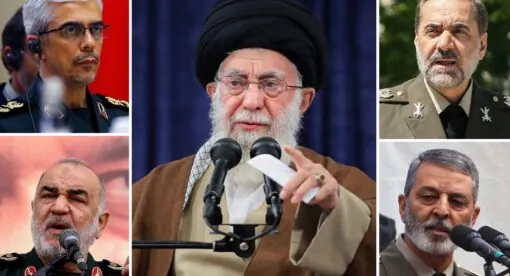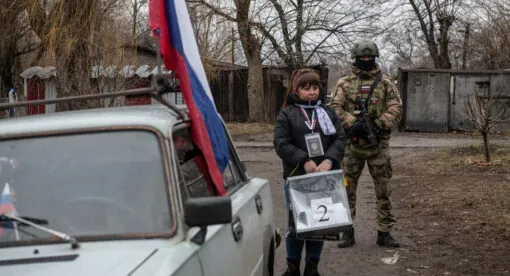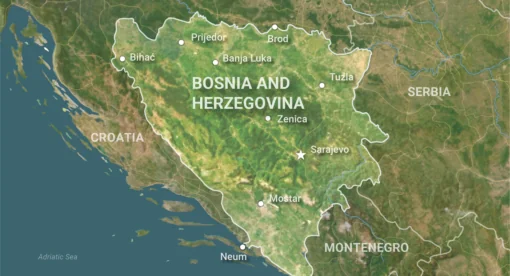Editor’s Note: This Terrain Analysis is part three of “ISIS 2020” – a series of briefings about the current status of the Islamic State by authors from different parts of the region. It is published by the Newlines Institute’s Nonstate Actors program. Parts one and two were released on April 28 and May 5, respectively.
Current trends in Iraq and Syria indicate that the Islamic State has entered a new yet unstable phase of recovery wherein it remains prone to military pressure from forces in Iraq and Syria but is projecting strength in villages and suburbs across the two countries. If the current trends continue, the group’s capabilities could allow it to gain momentum that will be difficult to reverse without deeper American engagement. The dilemma for Iraq and Syria now is that the reversal of the group’s current resurgence requires a deeper and longer engagement from the U.S.-led coalition. That engagement, however, has become less likely because of developments such as the brief U.S. withdrawal from Syria. Meanwhile, the Turkish military intervention in parts of northern Syria and the conflicts in both countries due to increased U.S.-Iranian hostility is strengthening ISIS.
Early Signs of a Resurgence
A recent spike of ISIS activity in parts of Iraq and Syria raised renewed fears about the revival of the group that some six years ago controlled a sizable region extending from Iraq’s northeastern Diyala province to Syria’s northwestern Aleppo governorate. Islamic State operations increased this year in places like Diyala, Salah al-Din and north of Baghdad in Iraq, and rural parts of Homs and Deir ez-Zor in Syria.

On April 9, the jihadist organization carried out multiple attacks on forces loyal to the Syrian regime and Iranian-backed militias in the desert and mountainous regions between Homs, Deir ez-Zor and the Syrian-Iraqi border. Numerous regime fighters were reportedly killed after the group intercepted and successfully ambushed pro-regime troops as they moved through the desert near Sukhnah in that region. Clashes between ISIS and pro-regime forces, also reported by pro-regime social media outlets, lasted for several hours, prompting intervention from the Russian air force. According to pro-regime sources, the clashes were initiated by the regime after intercepting ISIS movements in Homs.
The clashes in April came only 10 days after ISIS released a video cataloguing its attacks in the same region in the weeks and months prior, which provided a clear picture of the Islamic State’s capabilities in that area. The footage was reminiscent of old videos showing an active and vicious organization, with numerous foreign and local fighters engaged in open and heavy combat against pro-government forces. In the video, the jihadists are seen killing pro-regime soldiers, seizing their weapons and destroying their vehicles. In some cases, the jihadists would behead or execute regime fighters based on the task they performed as part of their military service: Bomb makers would be detonated with bombs attached to their bodies, artillery troops would be fired upon through an artillery shell, and so on.
That video demonstrated the Islamic State’s ability to operate freely in a tough geography important for the regime, Hezbollah, and other Iranian-backed militias, operating near the borders of Iraq, Syria, and Jordan. Nowhere else in both Syria and Iraq had the organization seemed this active since the collapse of its caliphate in March last year — until the organization launched large-scale and coordinated attacks in multiple areas in central and eastern Iraq in April.
On its own, the apparent uptick in the number of attacks does not necessarily mean the group has recovered. Such attacks happen from time to time, even in times of general weakness, especially in the sparsely-populated areas in the Syrian desert or near the Himreen Mountains in northern Iraq. In the Syrian desert, in particular, the group simply never went away. Fighters fleeing the last battles in Deir ez-Zor in 2018-2019 crossed the Euphrates River west and lay low in that area, taking advantage of the security vacuum and the terrain of unpopulated or sparsely-populated areas to hide and conduct frequent attacks. So, in the desert, mountains and abandoned villages, the spike in attacks would not necessarily indicate a significant change in the Islamic State’s status in Syria and Iraq.
However, a close look at the situation in different parts of Iraq and Syria shows that the attacks are only early signs that the sustained military momentum against ISIS last year in Syria and the last two years in Iraq has recently weakened. The organization started to benefit from a set of favorable developments that began in October, such as the chaos that followed the U.S. announcement to leave Syria and the subsequent and brief Turkish invasion of parts of northern Syria, as well as the unprecedented mass protests in Iraq that caused political paralysis in Baghdad for several months. Current trends indicate that the group has entered a new, although unstable, phase of recovery: It remains easy to contain through renewed military operations in Iraq and Syria but is currently projecting greater confidence in villages and suburbs across the two countries than it did several months ago.
If the current trends continue, the group’s attacks and capabilities in the next year will likely be comparable to its activities in 2012 and the early months of 2013, albeit not on the scale of the exponential growth seen later that year or in 2014. In other words, ISIS is recovering but it has not yet established a firm foothold that would enable it to frequently carry out large-scale attacks in Iraq and Syria, a scenario that will depend largely on a number of variables in the coming months. This means that the recent attacks may not be the new normal just yet.

‘Will of Victory’
To contextualize the Islamic State’s current delicate trajectory and explore its future prospects, it is important to recognize the group’s weakness and the sustained military pressure it faced in the year that followed the collapse of the caliphate. After the loss of its last town in the Euphrates River Valley region in eastern Syria, Baghouz, the Islamic State continued to face intense immense military campaigns but it was still able to maintain its internal structures and organizational ability to survive existential threats. This subtle mix of external operational weakness and internal organizational strength started to take a turn early this year, giving way to increased operational capabilities.
Iraqi authorities and the U.S.-led coalition launched a string of intensive campaigns across Iraq’s north and west in July 2019 under the slogan “Will of Victory.” The multi-phase campaigns, which continued to the end of the year, were in response to a number of factors: increased activity by the Islamic State, especially at night, and fears that fighters who fled the last pocket the group lost in Syria in March had crossed into Iraq.
Since the loss of its capitals in Mosul and Raqqa in 2017 and 2018, respectively, and specifically after the collapse of its physical caliphate in March 2019, ISIS reverted fully to insurgency tactics, including ambushes, house raids, extortion, assassinations, hit-and-run operations, and arson attacks. Frequent killings of mukhtars, or town officials, and the burning of farms raised fears within local communities, which increasingly became restless about the government’s failure to protect their communities against militant attacks.
The first part of the “Will of Victory” campaign kicked off on July 7, 2019, to mark the third anniversary of the liberation of Mosul. The operations during this first phase focused on the Islamic State’s former heartlands in Ninewa, Salah al-Din, and Anbar. In the same month, a second phase of operations was launched, which focused on Diyala and the areas north of Baghdad.
These campaigns put sustained pressure on the Islamic State. The following month, for example, Iraqi forces cleared 25 villages in Diyala. This was significant because the province had long been a preferred logistical hub for ISIS for movements from western and northern Iraq to the capital, Baghdad. Then-Iraqi Prime Minister Adil Abdul-Mahdi stated that the government forces did not encounter “real resistance” from the Islamic State in areas he said were often described as “dangerous.” These campaigns were persistent and spanned dozens of villages and towns, over several months. ISIS did not move in large numbers, and many of its fighters were scattered and acting within small cells, collectively estimated to be in the thousands. The intensity of such operations was captured in a video posted by the U.S.-led coalition’s spokesman on Twitter. “Here’s what it looks like when @USAFCENT #F15 and #F35 jets drop 36,000 Kg of bombs on a Daesh infested island,” he wrote, using the Arabic acronym for the Islamic State. The operation even made a cameo in the second statement made in late January by the organization’s new spokesman, Abu Hamza al-Qurayshi, when he mocked the Iraqi government’s “will of victory.”
In August 2019, the Pentagon issued a report warning that the Islamic State was rebuilding in remote areas that were hard for Iraqi forces to secure. In the same month, Iraqi authorities announced a campaign to bolster security in rural Anbar. Less than a month before Abu Bakr al-Baghdadi was killed, Iraqi media reported that the “Will of Victory” campaign struck several “rest-houses” in Anbar during its sixth phase in the first week of October, presumably near where the former head of the organization was hiding.
Al-Baghdadi’s death itself could have been a by-product of the relentless campaign against his organization in a geographic area vital for its survival and future re-emergence, namely Anbar and the border areas around it, making it an inhospitable environment for al-Baghdadi. After losing its centers in Iraq and Syria, ISIS’s menu of options for where to hide its leaders and stage a comeback shrank. Iraq had become significantly less safe to operate in after the Iranian-backed Iraqi government forces, along with Shiite militias, took control of the northern and western Sunni parts of the country and blocked the border crossings from Syria.
By April 2019, and especially after ISIS lost its last town in Syria, the group’s last bastion – the desert areas in Iraq westward near the Jordanian border – became vulnerable. By the spring of 2019, the only part of Syria not under the control of either the Assad regime or Kurdish forces supported by the United States was Idlib, Afrin, and the northern countryside of Aleppo. The sweeping operations in Iraq from July to December 2019 put immense pressure on the Islamic State and reached al-Baghdadi’s hideouts in Anbar before he took the journey to Idlib, where U.S. forces raided his location.
In October 2019, ISIS appeared to be in the direst situation since the collapse of its caliphate. The group was seemingly facing one of the most critical challenges to its operations since its establishment after the U.S. invasion of Iraq in 2003. Al-Baghdadi, ISIS’s leader since April 2010, detonated himself during a U.S. military raid on his hideout in Barisha, an obscure town in the northwestern Syrian province of Idlib and a stronghold of jihadist rivals of the Islamic State, on the night of Saturday, Oct. 26. The following day, the group’s spokesman, Abu al-Hassan al-Muhajir, was killed in another operation. In the months before they were killed, Al-Baghdadi and al-Muhajir were the only public-facing figures in the organization, issuing official messages about key events to the group’s followers. Their deaths in quick succession complicated the task of presenting a new leadership to the Islamic State’s support base.
Moreover, the death of the self-styled caliph al-Baghdadi came only seven months after the collapse of the physical caliphate he had established five years prior. The Islamic State lost its two best known leaders just as it was still trying – with mixed results – to cope with the demise of its physical caliphate. The Islamic State’s ability to expand beyond Iraq – to Syria in 2011 and rendering Iraq and Syria into a singular battlespace in 2014 – was possible in part because of its strategy and tradecraft that emphasized and delivered on the establishment of a caliphate. Thus, the collapse of that caliphate and the death of its caliph made ISIS more vulnerable to internal and external challenges to its survival, and strained its attempts to maintain operational relevance and, more critically at this point, jihadist legitimacy.
Squandering the Gains
In the same month ISIS seemed to suffer, a cycle of events opened new opportunities for it. U.S. President Donald Trump’s announcement that the United States would withdraw from Syria was followed promptly by a Turkish attempt to invade Syria and expel the Kurdish-dominated and U.S.-backed Kurdish forces from the north. The chaos then led the Kurds to strike a deal with Russia and the Syrian regime in a desperate bid to stop Turkey from seizing their areas. Washington eventually reversed its decision to leave Syria, but the map of northeastern Syria had already changed, and the confusion left an opening for ISIS. Iraq also faced crippling challenges, such as unprecedented mass protests that rocked Baghdad and the south and forced the government to resign, followed by political paralysis as Iraqis tried and failed (until last week) to agree on a new prime minister. Additionally, growing tensions between the United States and various Iraqi forces since December, which peaked after the killing of Iranian Maj. Gen. Qassem Soleimani on Iraqi soil, made it harder for Iraqi or international forces to focus on ISIS.
Despite such openings – and despite warnings from observers about alleged ISIS prison breaks and resurgence – ISIS showed no signs of recovery until recently. The reason, arguably, had to do with the immense military pressure that ISIS faced in its heartlands in Iraq and Syria, which it only started to overcome after a few months of the chaos caused by the events that began in October. After suffering major setbacks, ISIS went into a lengthy period of quiet before regeneration. The relentless campaign against ISIS in northern and western Iraq as well as in eastern and northern Syria limited the group’s ability to exploit events that would have otherwise given it an opening.

The situation has taken a turn this year, especially since April. The recent ISIS attacks in Syria and Iraq were preceded by underlying and more alarming trends in villages and towns across the two countries indicating the group was becoming more established and confident than it was only several months ago. Significantly, ISIS claimed it detonated five improvised explosive devices in different parts of the capital Baghdad this Monday. The attacks were in close proximity to Baghdad International Airport — within 5 miles. While attacks were small and had little effect, they indicate the organization is rebuilding its network in the well-guarded capital.
Increased mobility is discernible in the group’s ability, in the past few months, to directly approach locals warning them against working with its enemies. Such mobility is a warning sign of both a growing security vacuum and of ISIS’ recovery of its capabilities. Also, unlike a year ago, when many on the ground believed that the group was indeed defeated and might not return to their areas, local contacts also speak of growing fears over the group’s visibility, which tend to make them more reluctant to cooperate with authorities. As both Abdullah al-Ghadhawi and Husham al-Hashimi explained in previous pieces in this series, the group has stepped in to fill the void in much of Iraq and Syria in recent months.
The rise in attacks, combined with the increased visibility on a local level in both countries, indicate that ISIS is now a far more potent threat than it was a year ago. But this phase of its recovery remains unstable, and it is still too early to conclude that the group has made a firm comeback. Phrased differently, ISIS no longer faces the same pressure it faced last year, and this has enabled it to establish a foothold across Iraq and Syria but it has not yet consolidated this presence in either country. Its regeneration is recent and fragile, after at least a year of being under strain and several months of security and power vacuums and openings in both countries. This means that ISIS’s resurgence is easily reversible with a return of military pressure and clearing operations as happened last year in Iraq and Syria. Without such operations, ISIS is poised to consolidate this phase of its post-caliphate recovery.
The problem for Iraq, in particular, is that last year’s choking off of ISIS’s capabilities was made possible through intensive and intense military support by the U.S.-led coalition, which has recently withdrawn its forces from some tactical bases in Kirkuk, Qayyarah, and Anbar.
The short timeline between the collapse of ISIS’s caliphate, the series of events in October, and the spike of ISIS attacks since April offer obvious lessons, and solutions, for policymakers:
- ISIS was unable to conduct large-scale attacks last year due to sustained pressure by the U.S.-led coalition, which made it hard for the group to immediately seize significant openings like the U.S. withdrawal from Syria, the Turkish invasion, the popular protests in Iraq, and the killing of Soleimani.
- Political and military infighting after the killing of al-Baghdadi left a vacuum that enabled ISIS to exploit, even if that took several months.
- ISIS has also demonstrated that, despite sustained military pressure against it and despite upheavals like the death of its leader and the collapse of its caliphate, it can preserve its internal structures and communicate with its various sectors and foreign affiliates, without a single case of partition or fracture.
The political developments in Iraq and Syria since October undid much of the work done in the past two years to properly defeat ISIS. The dilemma for the two countries now is that the reversal of the group’s current resurgence requires a deeper and longer engagement from the U.S.-led coalition, but that engagement has become very unlikely because of the infighting that followed the withdrawal from Syria and the killing of Soleimani that had opened new doors for ISIS. This means that, while the containment of ISIS is relatively easy to achieve at this point, the resurgence of ISIS is a more likely scenario given the current political and military realities in both countries.
Hassan Hassan is the Director of the Human Security Unit at the Newlines Institute. He is also the Founder and Editor-in-Chief of Newlines Magazine, an initiative of the Newlines Institute. His research focuses on militant movements, nonviolent extremism, and geopolitics in the Middle East. Hassan has also served as a contributing writer at The Atlantic, The Guardian, and Foreign Policy.
The views expressed in this article are those of the author and not an official policy or position of the Newlines Institute.







